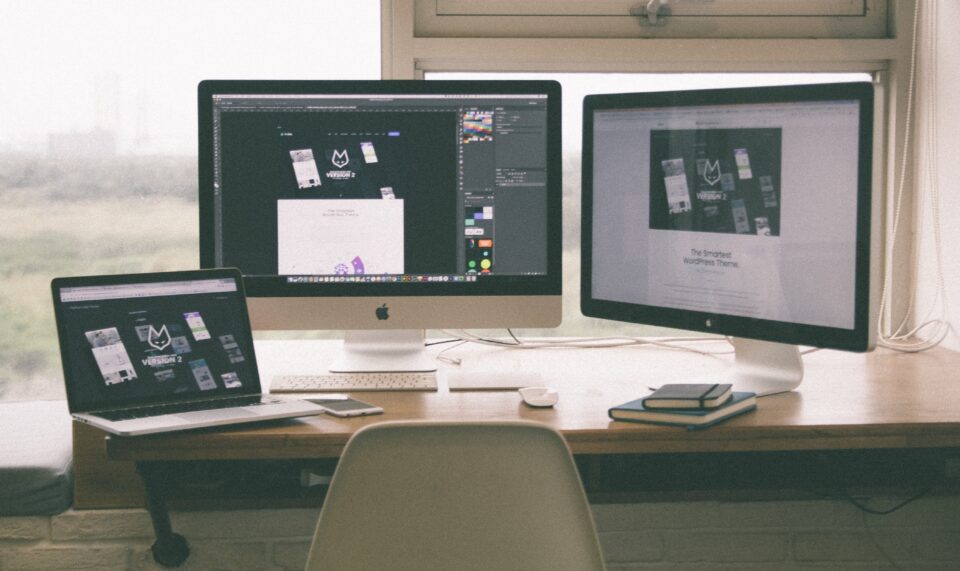The benefits of a multi-monitor setup are many. It increases your productivity, it enables a smooth program switching, it gives you more screen real estate and it can even reduce eye strain.
Pros of Having a Multiple-Monitor Set-up
If you’re not convinced that you need a multi-monitor set-up yet, here are some reasons that may change your mind:
Enhanced Productivity
Improved productivity can be achieved if you use an external monitor because it will allow you to view multiple applications simultaneously.
For example, if you are working on a spreadsheet and want to check your email, you won’t have to switch back and forth between windows on your computer screen. You can simply open another window on your external monitor.
With multiple screens, you will be able to work on various tasks at the same time. This means that you can complete tasks much faster than before while still maintaining focus on each individual task at hand.
Better organization
Having multiple screens means that you can easily arrange your windows so they’re all visible at once.
This allows you to see all the relevant information without having to scroll around or minimize windows as much as possible so they fit onto one screen; a common practice when working with only one monitor.
It also makes it easier to organize your workspace, since each monitor becomes its own “desktop” where you can place shortcuts or icons for frequently used applications and files.
More Screen Real Estate
If you’re a multitasker, or if you just want to see more of your work at once, then adding a second monitor to your desktop is one of the most useful upgrades you can make.
If you’re a designer or have a lot of screen real estate, this can be a great way to get more work done. For example, if you’re designing an app and need to see your code and the mock-up side by side, multi-monitors are a great way to do that.
Better Efficiency
The more space you have to work with, the easier it is to multitask efficiently. You don’t have to put up with a cluttered desktop or scroll through endless pages of open documents just trying to find what you need when using multiple monitors instead of one large display.
It’s much easier for users to focus on doing just one thing at a time when there’s no confusion about which window belongs where or why it’s taking up so much space.
Less Eye Strain
If you’re like me, you spend a lot of time staring at a computer screen. Over time this can lead to eye strain and even headaches if you don’t take steps to combat it.
By adding another monitor, you eliminate glare from your main monitor and increase the distance between your eyes and the screen so that they don’t have to work so hard just to focus on what’s in front of them.
Cons of Having a Multiple-Monitors Set-up
Cost
The downside of a multi-monitor setup is cost and space. High-quality monitors are more expensive than TVs. Unless you’re buying really cheap displays on craigslist, buying several monitors isn’t going to be cheap.
Space
If you don’t have a lot of desk space, the monitors might take over your entire workspace. If you have enough money and room on your desk, however, it’s worth considering getting a multi-monitor setup for your home office or business.

Factors to Consider when adding another Computer Monitor
The number of people who use multiple monitors is on the rise and for good reason. Whether you’re a graphics designer, an engineer, a gamer, or just someone who wants an extra screen for their email, a multi-monitor set-up can be incredibly beneficial. Here are factors to consider when upgrading to multiple monitors:
Cost
The first thing to take into consideration is the cost. Multi-monitor setups can be expensive and if you’re not ready to invest that kind of money in your setup, it may not be worth it for you. If price isn’t an issue though, then this won’t be an issue at all.
Your needs
The next factor to consider is your needs. For example, if you work in an office environment and have several tasks at once, then having multiple monitors might be beneficial for you because it allows you to multitask easily without losing track of any information.
However, if you only use computers occasionally or only have one task to complete at a time, then purchasing multiple screens may not be worth it because it’s expensive and takes up space on your desk.
When choosing the right size screen for your needs, make sure it fits in with the rest of your office furniture as well as possible so it doesn’t look out of place or crowded together on one desk space.
Numbers of Monitors that you Want
How many monitors can you afford? Most people who go for multi-monitors start with two screens as this provides enough space for multi-tasking.
Three screens seem to be the sweet spot for most people, giving them more space while still having enough room on each screen to keep the windows organized and easy to read. Four screens might be overkill unless you really need all that extra space or if your job involves working with several programs.


